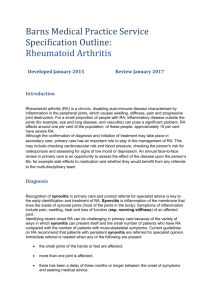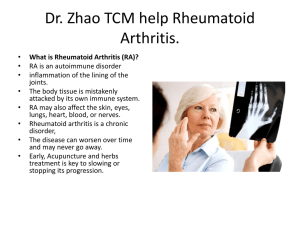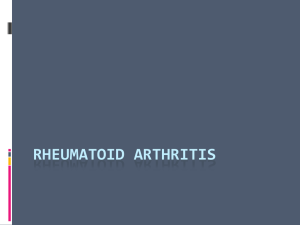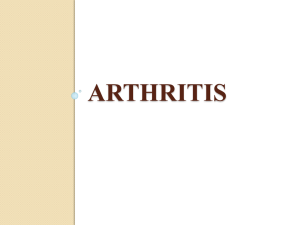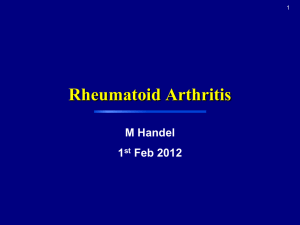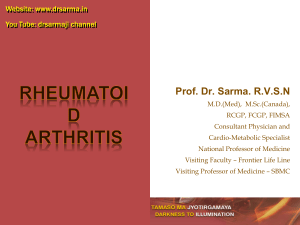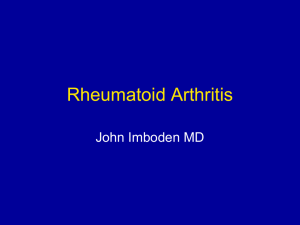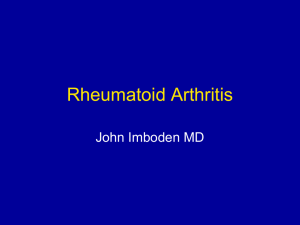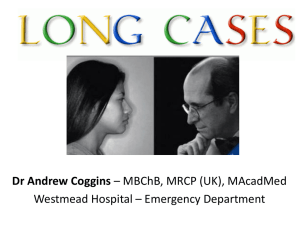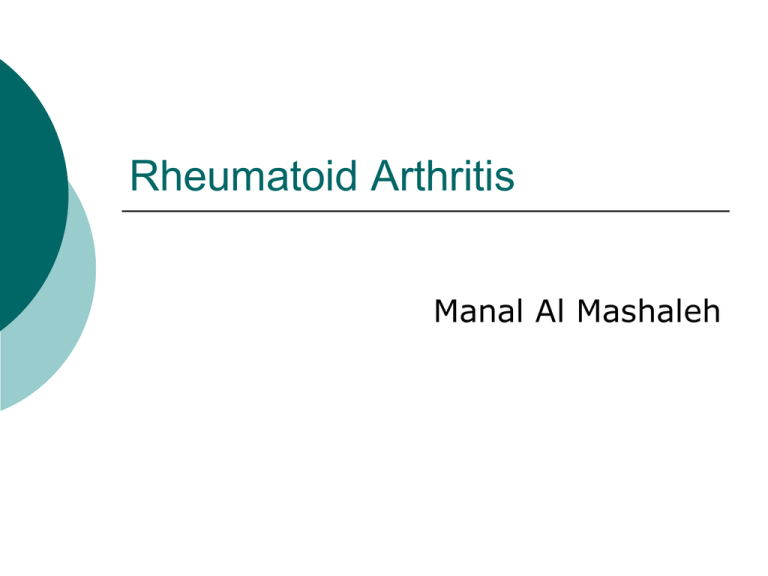
Rheumatoid Arthritis
Manal Al Mashaleh
Rheumatoid arthritis (RA) is a chronic
systemic inflammatory disease of
unknown cause.
An external trigger (eg, cigarette
smoking, infection, or trauma) that
triggers an autoimmune reaction, leading
to synovial hypertrophy and chronic joint
inflammation along with the potential for
extra-articular manifestations, is
theorized to occur in genetically
susceptible individuals.
History
The hallmark feature of rheumatoid arthritis (RA)
is persistent symmetric polyarthritis (synovitis)
that affects the hands and feet, although any joint
lined by a synovial membrane may be involved.
The severity of RA may fluctuate over time, but
chronic RA most commonly results in the
progressive development of various degrees of
joint destruction, deformity, and a significant
decline in functional status.
Extra-articular involvement of organs such as the
skin, heart, lungs, and eyes can also be
significant.
Signs and symptoms
In most patients with RA, onset is insidious, often
beginning with fever, malaise, arthralgias, and
weakness before progressing to joint
inflammation and swelling.
Signs and symptoms of rheumatoid arthritis may
include the following:
Persistent symmetric polyarthritis (synovitis) of
hands and feet (hallmark feature)
Progressive articular deterioration
Extra-articular involvement
Constitutional symptoms
The physical examination
Important to assess the following:
Stiffness
Tenderness
Pain on motion
Swelling
Deformity
Limitation of motion
Extra-articular manifestations
Rheumatoid nodules
The boutonniere deformity
nonreducible flexion at the PIP joint along with hyperextension of the distal
interphalangeal (DIP) joint of the finger.
Swan-neck deformity of the finger
Hyperextension at the PIP joint with flexion of the DIP joint
Rheumatoid nodules at the elbow
Diagnosis
No test results are pathognomonic
The diagnosis is made by using a
combination of clinical, laboratory, and
imaging features
Potentially useful laboratory studies in
suspected RA include the following:
Erythrocyte sedimentation rate
C-reactive protein level
Complete blood count
Rheumatoid factor assay
Antinuclear antibody assay
Anti−cyclic citrullinated peptide and
anti−mutated citrullinated vimentin
assays
Images
Radiography (first choice): look for
osteopenia, joint space narrowing and
erosions
Magnetic resonance imaging: Primarily
cervical spine
Ultrasonography of joints: Joints, as well
as tendon sheaths, changes and degree
of vascularization of the synovial
membrane, and even erosions
Joint aspiration and analysis of
synovial fluid may be considered,
including the following:
Gram stain
Cell count
Culture
Assessment of overall appearance
Differential Diagnoses
Fibromyalgia
Lyme Disease
Myelodysplastic Syndrome
Osteoarthritis
Paraneoplastic Syndromes
Polychondritis
Polymyalgia Rheumatica
Psoriatic Arthritis
Sarcoidosis
Sjogren Syndrome
Systemic Lupus Erythematosus
Treatment
Nonsteroidal anti-inflammatory
drugs (NSAIDs)
Corticosteroids
DMARDS
Biologic TNF-inhibiting DMARDs
Biologic non-TNF DMARDs
Surgical treatments
Synovectomy
Tenosynovectomy
Tendon realignment
Reconstructive surgery or
arthroplasty
Arthrodesis
Prognosis
Outcome in RA is compromised when
diagnosis and treatment are delayed
The clinical course of RA is generally
one of exacerbations and remissions
Prognostic factors
It has been shown that intervention with DMARDs in
very early RA (symptom duration < 12 weeks at the
time of first treatment) gives the best opportunity for
attempting to achieve disease remission
HLA-DRB1*04/04 genotype
High serum titer of autoantibodies (eg, RF and ACPA)
Extra-articular manifestations
Large number of involved joints
Age younger than 30 years
Female sex
Systemic symptoms
Insidious onset
RA affects several organ systems, as
follows:
Cutaneous: Subcutaneous nodules (rheumatoid nodules)
,vasculitic lesions as purpura or skin ulceration , palmar
erythema and pyoderma gangrenosum
Cardiac: Myocardial infarction, myocardial dysfunction, and
asymptomatic pericardial effusions are common; symptomatic
pericarditis and constrictive pericarditis are rare. Myocarditis,
coronary vasculitis, valvular disease, and conduction defects
are occasionally observed
Pulmonary: pleural effusions, interstitial fibrosis, nodules,
and bronchiolitis obliterans organizing pneumonia.
Methotrexate therapy can induce interstitial fibrosis that may
be difficult to distinguish from that which naturally occurs in
patients with RA.
Hematologic : anemia of chronic disease,
normochromic-normocytic anemia,
thrombocytosis. Leukopenia is a finding in
patients with Felty syndrome.
Neurologic :Nerve entrapment is
common, mononeuritis multiplex, and
cervical myelopathy
Ocular: Keratoconjunctivitis sicca is
common , episcleritis, uveitis, and
nodular scleritis that may lead to
scleromalacia
Renal: not directly affected by RA. Secondary
involvement is common, including that due to
medications (eg, nonsteroidal anti-inflammatory drugs
[NSAIDs], gold, and cyclosporine), inflammation (eg,
amyloidosis), and associated diseases (eg, Sjögren
syndrome with renal tubular abnormalities).
Gastrointestinal (GI): secondary to s medication
effects, inflammation, and other diseases. The liver
may be affected in patients with Felty syndrome (ie,
RA, splenomegaly, and neutropenia).
Vascular: Vasculitic lesions as palpable purpura, skin
ulcers, or digital infarcts.
2010 ACR/EULAR Diagnostic
Criteria
Historically, the diagnosis of RA was
based on the 1987 American
College of Rheumatology
The ACR/EULAR classification system
is a score-based algorithm for RA that
incorporates the following 4 factors:
Joint involvement
Serology test results
Acute-phase reactant test results
Patient self-reporting of the duration
of signs and symptoms
The maximum number of points possible is 10.
A classification of definitive RA requires a score of 6/10 or higher.
Patients with a score lower than 6/10 should be reassessed over time.
If patients already have erosive changes characteristic of RA, they meet the definition
of RA, and application of this diagnostic algorithm is unnecessary.
Joint involvement consists of swelling or tenderness upon examination. The presence of
synovitis may be confirmed on imaging studies. Points are allocated as follows:
1 large joint (ie, shoulders, elbows, hips, knees, ankles) = 0 points
2-10 large joints = 1 point
1-3 small joints (with or without involvement of large joints), such as MCP, PIP, second
to fifth MTP, thumb interphalangeal (IP), and wrist joints = 2 points
4-10 small joints (with or without involvement of large joints) = 3 points
More than 10 joints (at least 1 small joint, plus any combination of large and additional
small joints or joints such as the temporomandibular, acromioclavicular, or
sternoclavicular) = 5 points
At least 1 serology test result is needed
for RA classification. Points are allocated
as follows:
Negative rheumatoid factor
(RF) and negative anti−citrullinated
protein antibody (ACPA; in the
ACR/EULAR criteria set, tested as
anti−cyclic citrullinated peptide [antiCCP]) = 0 points
Low-positive RF or low-positive ACPA = 2
points
High-positive RF or high-positive ACPA = 3 points
At least 1 test acute-phase reactant test result is
needed for classification. Local laboratory
standards determine which results are normal and
which are abnormal. Points are allocated as
follows:
Normal C-reactive protein (CRP) and normal
erythrocyte sedimentation rate (ESR) = 0 points
Abnormal CRP or abnormal ESR = 1 point
Points for the patient’s self-reporting of the
duration of signs or symptoms of synovitis in
clinically involved joints are allocated as follows:
Shorter than 6 weeks = 0 points
6 weeks or longer = 1 point
Morbidity and mortality
Cardiovascular disease : leading
cause of excess mortality
Infection
Respiratory disease
Malignancies: Hodgkin disease
Osteoporosis
Felty’s syndrome
Seronegative Arthritis
Refers to a diverse group of
musculoskeletal syndromes linked by
common clinical features
and common immunopathologic
mechanisms.
The entities include
Psoriatic arthritis
Reiter’s syndrome
Enteropathic arthritis
Reactive arthritis
Ankylosing spondylitis
Undifferentiated seronegative arthritis
Whipple’s disease
Arthritis associated with pustular acne
Post-intestinal bypass arthritis
HIV associated arthritis
NOSOLOGY
Spondylarthropathy
Seronegative spondylarthropathy
Seronegative arthritis
BASE syndrome (B27,arthritis,
spondylitis, enthesopathy)
The disease is often incorrectly
referred to as seronegative
rheumatoid arthritis. This is
incorrect because the demographics
and clinical presentations of the
diseases within this group differ
markedly from rheumatoid arthritis.
KEY CLINICAL FEATURES
In contrast to rheumatoid arthritis, seronegative
arthritis is male predominant (with exception of
psoriatic arthritis where M=F).
The age of onset is variable and disease may start in
the teens or early twenties.
The arthritis tends to run a waxing and waning
course with spontaneous exacerbations and
remissions.
Inflammation occurs not only in the joints, but in the
spine and at tendon attachment points (entheses).
The arthritis is often asymmetric and has
a tendency to involve the large joints of
the lower extremities and the feet and
ankles.
Sometimes an entire digit is swollen,
producing what is known as sausage digit
or dactylitis.
Uncontrolled inflammation tends to result
in stiffening and loss of motion as well as
in damage to cartilage.
What distinguishes this group of diseases
from one another and from rheumatoid
arthritis are a wide range of non-articular
features which include psoriasis and nail
changes, inflammatory eye disease,
inflammatory bowel disease, canker
sores, and urethritis.
The disease frequently runs in families
where it is linked to HLA genes including
but not limited to HLA B27.
TREATMENT
Non-steroidal anti-inflammatory agents
(NSAIDS)
Non-biologic DMARDS (methotrexate,
leflunomide, azulfidine)
Biologic agents (Enbrel, Humira,
Remicade).
Topical treatments for skin and eye
disease
Physical therapy to maintain range of
motion in joints, tendons and the spine.


